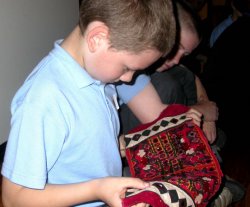Teachers and gallery professionals have much to learn from each other. Esmé Ward and Julie Howse explain.
At the University of Manchesters Whitworth Art Gallery, teachers are valued for their different perspective and expertise, particularly in giving us advice on displays and programme development through meetings and focus groups. However, if we fail to look beyond their advisory role, we can undervalue teachers and miss the opportunity to fully realise the potential of the gallery as a site for learning. Over the past three years, the Whitworth has started to explore the teacher/gallery relationship in much more depth.
We believe that the tensions between the more open-ended discursive learning encouraged in galleries and the skills-focused, often outcome-driven teaching of the classroom have often been overstated. Increasingly, schools are looking beyond the classroom for rich experiences that motivate and inspire their pupils and the Government has finally acknowledged the value of such learning1. Accordingly, museums and galleries like the Whitworth are working harder than ever to meet the needs of educators, enriching the curriculum and also raising pupils aspirations and attainment through more integrated partnerships with teachers and schools.
What might a more integrated partnership with a teacher or school look like?
- Teachers become creative collaborators, developing planning cycles that place collections at the heart of the curriculum and enabling pupils to build long-term relationships with gallery staff, collections and sites. This might mean shorter, focused visits on a more regular basis. For example, a local primary school has visited more than 30 times in the past 12 months.
- Last year, Julie Howse, a teacher from Birchfields Primary School in Manchester, used the Whitworth as an alternative classroom for a day a week throughout the year. All teaching, across the school, took place out in the galleries in front of the collections.
- Manchester-wide programme MAGPIE (of which the Whitworth is a key partner) aims to develop attainment in literacy at KS2 through the use of museums and galleries. Over 40 schools are now partners in this programme, developed by a hub-funded, primary consultant post based in Manchester Local Authority2.
- Over the past two years, the Whitworth has hosted a series of placements for teachers at both primary and secondary levels, with a focus on researching the collections and developing age-appropriate resources. These placements have been funded by engage (the association of gallery educators) as part of its Watch this Space scheme.
- We are currently hosting an 18-month secondment of a primary school teacher, one day a week, to develop a programme for Initial Teacher Trainees, funded by MLA North West Hub through Renaissance in the Regions.
The secondment of Julie Howse, has provided the greatest insight into the complex nature of the relationship between gallery and school. Julie has observed some key differences between the two working environments. These range from different funding structures, levels of autonomy and institutional priorities, to a distinctive gallery-based vocabulary that reflects concerns beyond the education sector.

Julie has welcomed the creative and collaborative approach to developing learning programmes in a gallery context, compared with the more solitary teaching practice of the classroom, and relished the opportunity to work closely and build relationships with people who have no experience of working in the education sector. The secondment is a key part of Julies continuing professional development (CPD), giving her the opportunity to reflect on practice and develop knowledge of the cultural sector.
The Whitworth Art Gallerys Learning Team is made up of ex-teachers, artists and academics. Julie provides an additional perspective, grounded in practice, and access to current developments in primary education, as well as an insight into school life. This has proved invaluable. Weve talked about how we can support teachers to work in different ways and support their risk-taking. Julie has been pivotal to this discussion and in the formulation of an approach to CPD and training that mixes theory and practice.
Like many arts organisations, the Whitworth is increasingly focusing on the future and developing closer links with Initial Teacher Training providers and trainees to ensure that the integrated use of museum and galleries forms a key part of their practice. Who better to take on this role than a practising teacher who also plays a key role in developing learning programmes in a gallery context?
The secondment model works because of its focus and scale, and plans are already underway to develop future secondments within the secondary or post-16 sector. Of course, personality and circumstances (like the proximity of a school and timetabling commitments) play a significant role in the effectiveness of any partnership with teachers. Developing sustainable qualitative relationships with schools takes effort and time but in our experience it is time well spent.
Esmé Ward is Head of Learning & Interpretation at the Whitworth Art Gallery.
e: esme.ward@manchester.ac.uk.
Julie Howse is Initial Teacher Training Co-ordinator, on secondment until April 2008
e: julie.howse@manchester.ac.uk
1 Learning Outside the Classroom. DfES. 2006
2 For details of MAGPIE, go to http://www.mewan.net



